Scar Treatment
Scars develop as part of the body’s healing process in response to injury, infection, burns, or inflammation. They can appear as flat, depressed, raised, hyperpigmented, hypopigmented, or tightened skin and can form anywhere on the body. Most scars result from damage to the underlying skin tissue, impairing collagen fiber formation during healing. While scarring is a natural process, the appearance of scars can negatively impact self-esteem and confidence. Fortunately, Dr. Michele Green in New York City is an expert in improving the appearance of various types of scars. Dr. Green specializes in treating all kinds of scars, including acne scars, stretch marks, surgical scars, keloids, and hypertrophic scars.
Dr. Green provides a wide range of scar treatments in her private dermatology office in NYC. Laser skin resurfacing options, including Fraxel, eMatrix, and Clear + Brilliant, are among the most effective treatments for atrophic acne scars and chickenpox scars. Laser therapy, such as the VBeam laser, is considered the gold standard for reducing redness linked to surgical scars, stretch marks, post-inflammatory hyperpigmentation, and keloids. Dermal fillers like Restylane, Voluma, and Sculptra can be combined with subcision to stimulate new collagen production and restore lost volume. Other common scar treatment options consist of microneedling, chemical peels, Botox, and intralesional cortisone injections. These non-invasive procedures involve little to no downtime or side effects and yield consistently impressive results. Dr. Green may also suggest using topical silicone gel sheets or creams between treatments to enhance cosmetic outcomes. Regardless of whether your scars are depressed or raised, or whether they result from surgery or acne breakouts, Dr. Green is here to assist you.
Dr. Michele Green is an internationally renowned, board-certified dermatologist with over two and a half decades of experience providing some of the world’s most discerning individuals with top-notch non-invasive cosmetic procedures, including scar treatments. She is consistently recognized as one of New York’s best dermatologists by Super Doctors, Castle Connolly, New York Magazine, and The New York Times for her dedication to her patients and her expertise. Dr. Green employs a holistic approach to cosmetic dermatology, treating patients with a “less-is-more” philosophy to achieve natural, youthful-looking results that endure. When you consult with Dr. Green at her private dermatology office in Manhattan’s Upper East Side regarding scar revision, she will collaborate with you to develop a customized scar treatment plan that best suits your skin type, the nature of the scar, and your overall aesthetic goals.
What is a scar?
A scar is a lesion or mark that forms as a result of skin damage from a burn, surgery, acne breakout, injury, or infection. Scars can occur on any part of the body, and their appearance mainly depends on the origin of the injury or lesion, how the body heals, and the formation of the wound. Some scars appear depressed, while others may be raised and can even grow larger than the original injury. If the skin injury extends deeper than the top layer, the scar tissue that forms is often thicker than normal skin. For individuals with lighter skin tones, scars typically develop as pink or red and may fade over time or alter to become darker or lighter than their natural skin color. Conversely, for those with darker skin, scars can often appear as dark marks on the skin’s surface. Regardless of the type of scar, Dr. Green offers a wide range of non-surgical scar treatments aimed at reducing the appearance of scars and helping you achieve clear, smooth, radiant skin.
What are the different types of scars?
Various factors, including the origin of the injury, one’s genetics, and ethnicity, can influence scar formation. Different types of scars can have other appearances and textures, including the following:
Contracture Scars – Contracture scars are characterized by tightened skin that makes moving the affected area more difficult. They typically form after a large area of skin is damaged, such as with a burn, and can be a hindrance if the scar formation happens over a joint or if the scar tissue affects a muscle or nerve.
Atrophic Scars – Atrophic scars are characterized by indentations or sunken patches of skin that form due to insufficient collagen production during the skin’s healing process. These scars often form due to inflammatory acne breakouts or lesions relating to an illness like chickenpox. The three different types of atrophic scars include ice-pick, boxcar, and rolling scars. Ice-pick scars are narrow, V-shaped indentations that penetrate deep into the skin. Boxcar scars are wide, round- or oval-shaped indentations with well-defined edges. Rolling scars are shallow, wavy indentations in the skin. Atrophic scars may become more visible with age as the natural loss of collagen further accentuates the indentations in the skin.
Hypertrophic Scars — Hypertrophic scars are characterized by raised caused by too much collagen produced during natural healing. While hypertrophic scars can fade over time, they will never truly flatten out. Hypertrophic scars will not grow beyond the area of the initial injury.
Keloid Scars — Keloid scars are also raised scars that differ from hypertrophic scars in that they grow in size past the area of the injury throughout the healing process and beyond. Red-headed patients and patients of African, Hispanic, or Asian heritage are more likely to develop keloid scars. The overgrown scars may affect a patient’s movement if the scar tissue grows over a joint. Keloids may be flesh-colored, erythematous, or hyperpigmented. Keloids are benign growths that may cause burning, itching, or pain in the affected area. Keloids do not resolve on their own or regress over time.
Flat Scars – Flat scars are characterized by discoloration of the skin’s surface. These scars may be slightly raised when the wound healing occurs at first but will flatten out over time. The scar may begin as pink or red and become either hypopigmented (lighter) or hyperpigmented (darker) than the surrounding skin.
Stretch Marks – Stretch marks occur on the skin’s surface when the skin expands or shrinks rapidly over a short period, which can occur frequently due to pregnancy or rapid weight gain or loss. The stretching of the skin causes damage to the underlying tissue, resulting in a scar. At first, stretch marks often appear pink or red but will fade to a silvery color over time.
Where does scar tissue come from?
Scar tissue forms when damaged skin undergoes the natural healing process. An infection, injury, burns, or inflamed skin tissue can result in scar development. Part of the healing process involves the production of a naturally occurring skin protein, collagen. Collagen is the most abundant skin protein, contributing to its structural support, firm foundation, and smooth texture. During the natural healing process, collagen fibers form tissues that knit the skin back together to repair the wound. The tissue that develops helps to protect the damage from infection, and it is this tissue that can lead to the appearance of a scar. When excess collagen is produced, the result is a keloid or hypertrophic scar. If insufficient collagen is produced, the result is an atrophic scar. The shape, size, and texture of a scar depend mainly on the cause of the wound and your age, genetics, and skin type.
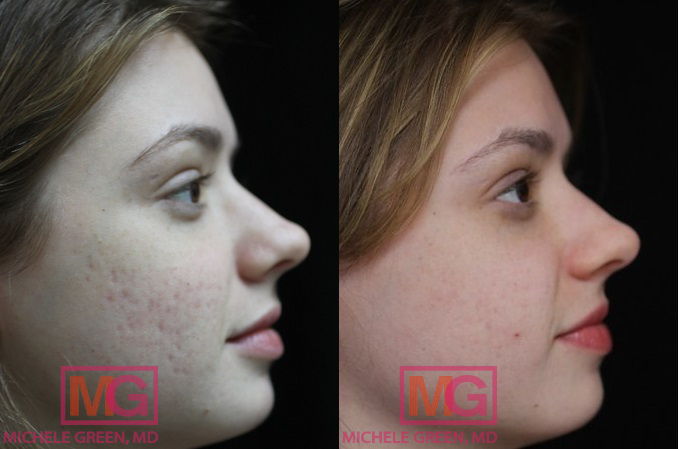
How can I remove my scars?
The first step in scar removal is consulting an experienced board-certified dermatologist, such as Dr. Michele Green in NYC. Consulting an experienced healthcare professional regarding scar treatment is critical, as some treatment options aren’t suitable for patients of every skin tone or type. Some of the most popular non-invasive treatment options in Dr. Green’s private NYC dermatology office include laser skin resurfacing, chemical peels, microneedling, dermal fillers, Botox, steroid injections, and topical treatments such as silicone gel sheets. Some dermatologists may offer options such as cryotherapy, a process by which scar tissue is frozen off with liquid nitrogen. Treatment options such as cryotherapy are outdated because they are less effective and have a higher risk of potential side effects. Dr. Green offers safe, effective, and non-invasive scar treatment options that will leave you with clear, radiant skin that lasts. When you consult with Dr. Green, she will assess your skin condition, thoroughly review your medical history, and review any previous cosmetic scar treatments you may have had. Depending on her evaluation, the location and type of scar, and your skin tone and type, Dr. Green will personalize a scar treatment plan that best suits your unique needs and aesthetic goals.
VBeam Pulsed Dye Laser treatment
The VBeam laser is considered the gold standard when it comes to reducing visible redness, including that which is associated with various types of scars, such as acne scars, surgical scars, stretch marks, keloids, burn scars, and post-inflammatory hyperpigmentation. This laser treatment operates on a wavelength of 595 nm, which exclusively targets red pigmentation in the skin while leaving the surrounding skin unaffected. As it is used to target redness, VBeam is also an excellent treatment option for correcting the appearance of broken blood vessels, rosacea flare-ups, and other pigmented lesions. The VBeam does not involve any downtime, meaning patients can resume their normal daily activities immediately after the procedure. Most patients note that the VBeam laser treatment is painless, describing the sensation as akin to a rubber band snapping against the skin. It is also equipped with a Dynamic Cooling Device, which emits a burst of cool air before each laser pulse to enhance the comfortability of the laser treatment for the patient. Most patients require an initial series of 4-6 VBeam laser treatments to achieve their ideal results. To maintain the best results, Dr. Green recommends limiting sun exposure in the treated area and layering two types of broad-spectrum sunscreen to ensure optimal coverage: first, a chemical sunscreen, followed by a mineral sunscreen.
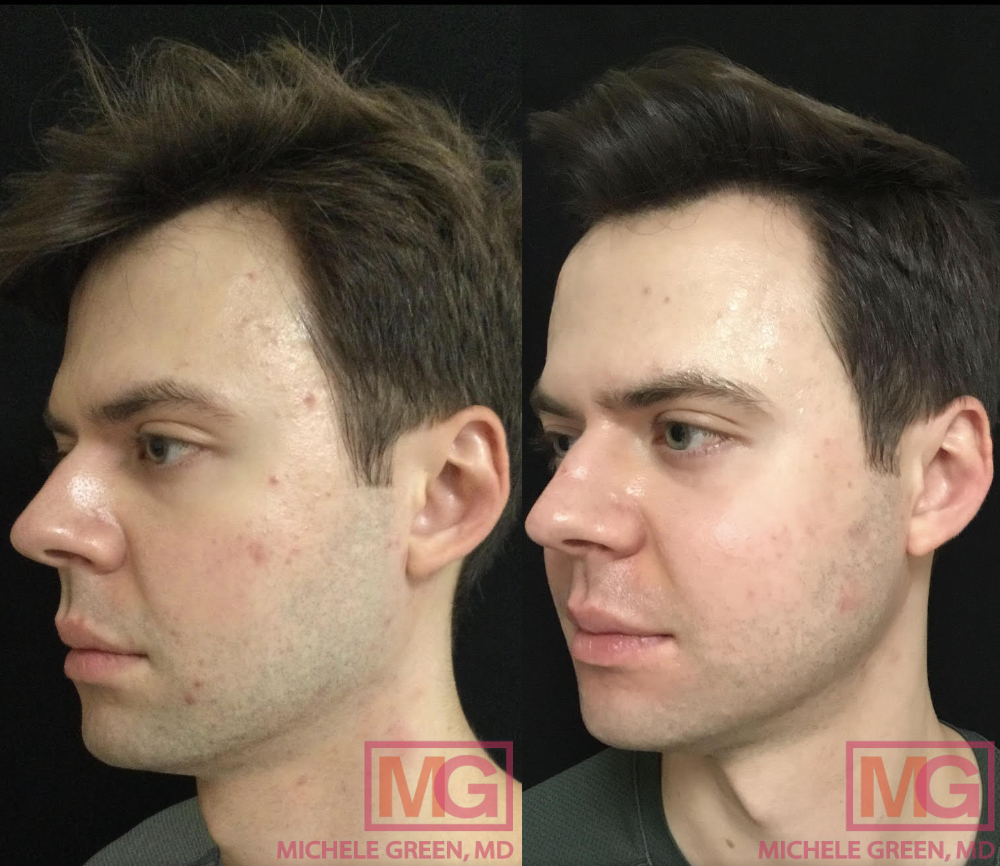
Fraxel Laser treatment for scars
Dr. Green often refers to the Fraxel laser treatment as the “magic eraser” for its unique ability to target a wide range of skin conditions, including the appearance of scars. The Fraxel operates on two distinct wavelengths of light, 1550 nm, and 1927 nm, to effectively improve skin texture and tone, depending on the patient’s needs and goals. In regard to improving the appearance of scars, Fraxel is most suitable for treating atrophic or depressed scars, such as surgical or acne scars and stretch marks. With the 1550 nm wavelength, the Fraxel creates controlled, precise micro-injuries in the dermis. This process stimulates new collagen production and, over time, creates a smoother, firmer skin texture and a reduced appearance of scars.
As a non-ablative fractional laser treatment, Fraxel leaves the outermost layer of skin intact, which significantly shortens the downtime required. Patients typically experience mild redness or swelling for 48 hours after treatment. Most patients require a series of three to five Fraxel laser treatment sessions to achieve ideal results in regard to scar revision, with each treatment approximately one month apart. Many patients choose to engage with Fraxel maintenance treatment sessions to keep up with results and stay ahead of future collagen breakdown as a result of natural aging. When you have Fraxel laser treatment with Dr. Michele Green at her private dermatology office in Manhattan’s Upper East Side neighborhood, she will work with you to establish a treatment timeline that best suits your needs and goals.
eMatrix laser treatment for scars
The eMatrix laser is widely utilized to diminish the visibility of atrophic acne scars and stretch marks. Each pulse of the eMatrix emits radiofrequency energy that heats the dermis, leading to controlled skin injury and activating fibroblasts, which trigger a wound healing response and generate new collagen. By targeting the deeper layers of the dermis and bypassing the epidermis, eMatrix treatment reduces both the downtime required and the likelihood of experiencing unwanted side effects typically associated with more aggressive treatments, such as skin discoloration and scarring. Patients generally experience about two days of downtime associated with the eMatrix treatment, during which they may notice common side effects like mild redness, swelling, or a sensation of heat in the treated area. The eMatrix is an effective laser skin resurfacing treatment that is safe for individuals of all skin types and tones, including darker skin tones, which are often more susceptible to these unwanted side effects with other laser treatments. Most patients require a short series of 4-6 eMatrix laser treatments for optimal scar revision, with each session spaced approximately four weeks apart. Patients with more pronounced scars may need additional treatment sessions. Besides enhancing the appearance of scars, the eMatrix is frequently used to minimize the visibility of fine lines, wrinkles, and enlarged pores.
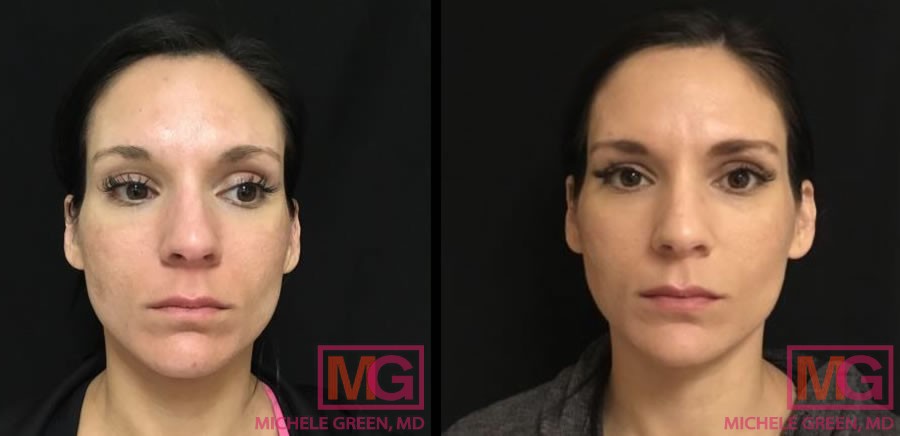
Botox Injections for scars
Botox is one of the most popular non-invasive cosmetic treatment options for facial rejuvenation. It is considered the gold standard for eliminating the appearance of dynamic fine lines and wrinkles. Botox is a neuromodulator that inhibits nerve signaling when injected into targeted muscles. It is commonly used to reduce fine lines on the forehead, between the eyebrows (glabella), and around the eyes (crow’s feet). One lesser-known yet incredibly effective application of Botox is its ability to reduce the appearance of scars following cosmetic facial surgery. A study published by the American Academy of Dermatology showed that Botox was injected into half of the test subjects immediately after a plastic surgery procedure on their face.
Researchers found that those patients had smaller and flatter surgical scars compared to those who did not receive the Botox treatment. They postulate that this effect is due to Botox’s ability to limit movement around the wound as it heals, which may help prevent the scar from becoming overly raised and reduce discoloration. The cosmetic effects of Botox tend to last for approximately four months, with many patients opting for regular maintenance treatments on a quarterly basis. It is important to receive Botox injections from a board-certified expert, such as Dr. Michele Green in NYC, to ensure safe and effective results. Dr. Green was among the first dermatologists in New York to offer cosmetic Botox injections, is an Allergan Platinum injector, and provides what have been described as the ‘best Botox injections’ in the NYC area.
Dermal fillers to treat scars
Dermal fillers are cosmetic injectables designed to enhance facial contours, augment certain features, replenish volume loss, and create a more youthful appearance. Dermal fillers can be an incredibly effective tool in scar revision, particularly for restoring volume to atrophic scars. Subcision is commonly performed in conjunction with filler treatment for scar revision, which entails using the fine needle of the syringe to break up scar tissue and stimulate collagen production. Performing subcision with filler injections provides immediate and long-lasting rejuvenation results. Dr. Green employs a wide variety of dermal fillers at her private dermatology office in NYC.
To treat depressed scars, Dr. Greem frequently uses Restylane and Juvederm fillers and injects them straight into the scars themselves. The Restylane and Juvederm fillers are composed of a substance called hyaluronic acid, which binds with naturally occurring water in the skin to replenish lost volume. The cosmetic effects of hyaluronic acid fillers are immediate and tend to last 6-18 months, depending on the amount and type of filler used and the patient’s metabolism. For some patients, acne scarring can result in diffuse volume loss across areas of the face, like the cheeks and temples. In this case, Dr. Green may use Sculptra, a unique filler made of something called poly-L-lactic acid, which stimulates gradual collagen production in the treatment area. Most patients require about three treatment sessions with Sculptra filler to achieve their ideal results, after which results can last up to two years. The type of filler selected for your scar treatment will be determined by Dr. Green during your consultation, depending on the types of scars present.
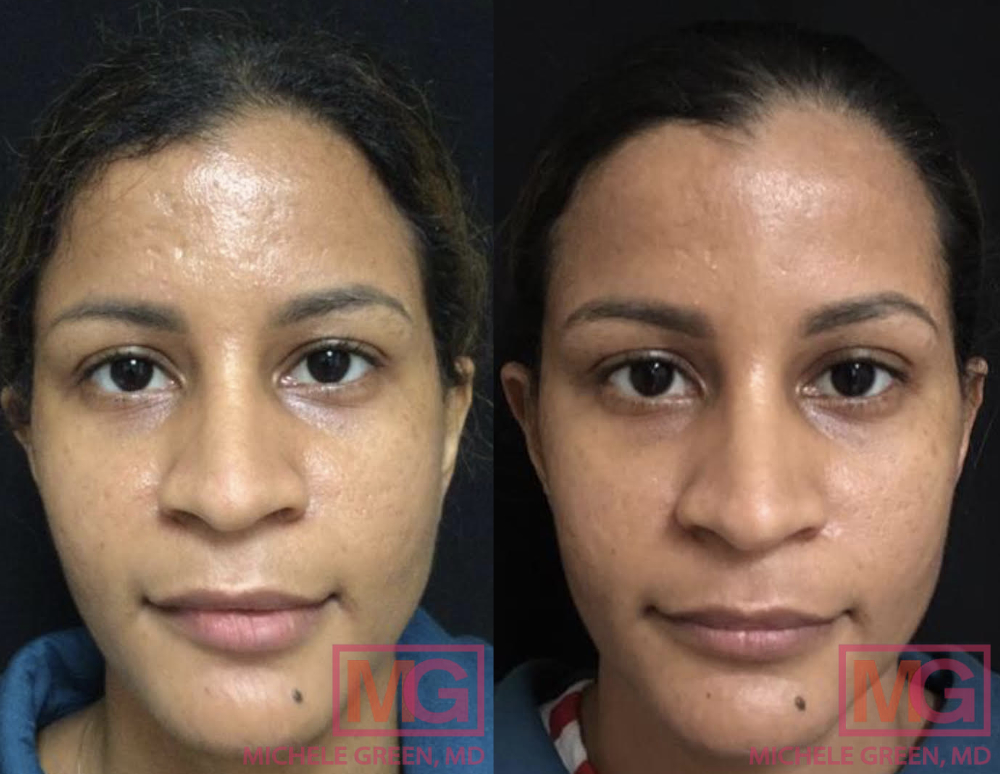
Restylane – 2 syringes for scar treatment
TCA peels
A chemical peel is a non-invasive skin resurfacing treatment that accelerates skin cell turnover and increases collagen production to reveal a smoother, brighter complexion that is more even in texture and tone. Trichloroacetic acid (TCA) peels are commonly used in Dr. Green’s dermatology office to treat active acne, post-inflammatory hyperpigmentation, and mild atrophic scars, such as depressed acne scars. During a chemical peel, the chemical solution is topically applied to the top layer of the skin. The solution reacts with the skin’s surface to exfoliate the skin’s outer layer, removing pigmented, dead skin cells to bring bright, healthy skin cells to the skin’s surface. Most patients require a series of chemical peel treatments to achieve their ideal results. TCA peels are typically not suited for patients with Fitzpatrick type 3 or darker skin, as there is a greater risk of developing unwanted hyperpigmentation as a side effect.
TCA Cross
TCA cross is a scar treatment that is reserved for a specific type of scar-atrophic ice-pick acne scars. During the treatment, the healthcare provider deposits a small amount of highly concentrated TCA directly into the scar depressions with a tool like a toothpick. TCA Cross differs from a TCA chemical peel, which involves applying the solution in a lesser concentration to the entire face. When placed directly into the deep scars, the TCA Cross triggers the body’s natural healing process, producing collagen and elastin, which fill the depressions. Most patients undergo a series of 3-5 treatments for optimal results, each spaced 6-8 weeks apart. The production of new collagen can begin as little as four weeks following the treatment, with ongoing improvements to the skin surface for as long as four months following each treatment session.
Mesopeels
Mesopeels are specially formulated peels designed to address hyperpigmentation and dark marks on the skin. Mesopeels are designed with skin-lightening agents like azelaic acid and tranexamic acid to fade unwanted pigmentation and reduce melanocyte activity in the skin. These gentle peels can be used on many areas of the body, including sensitive areas like the axilla, inner thighs, and groin. Mesopeels are safe and effective for all skin tones, including darker tones, making them an excellent treatment option for reducing flat, pigmented scars on the skin. Patients typically undergo four to six treatment sessions to see the best cosmetic results.
Microneedling
Microneedling, also referred to as collagen induction therapy, is a cosmetic treatment option that can improve both skin texture and tone. Microneedling is a procedure that delivers controlled trauma to the skin’s surface via a handheld device containing tiny, sterile microneedles. These microneedles penetrate the epidermis, the outermost layer of the skin, inducing the skin’s natural healing process to increase skin cell turnover and stimulate new collagen production. In addition to improving the appearance of fine lines, enlarged pores, uneven skin tone, and dullness, microneedling can be an excellent treatment option for depressed or atrophic scars. Most patients require an initial series of 4-6 treatment sessions, with each spaced approximately one month apart, to replenish collagen levels and improve the appearance of acne scars. Patients with more severe scarring may require additional treatments.
Microneedling is a safe and effective scar treatment option for all skin types and tones, and its effects can be further enhanced by pairing it with special topical serums. Serums applied topically during a microneedling procedure enter the microchannels, allowing for maximum absorption and better results. Patients experiencing pigmentation from scarring can pair microneedling with a depigmentation serum to fade dark marks. Platelet-rich plasma (PRP) can also be incorporated into the procedure to enhance the benefits of treatment. PRP is serum derived from a sample of the patient’s blood, which is spun in a centrifuge to separate it from the red blood cells. It contains an abundance of natural growth factors and proteins involved in the healing process, promotes circulation, stimulates collagen growth, and accelerates skin regeneration. The PRP is applied topically onto the skin after the microneedling device and enters the microchannels it creates, allowing for maximum absorption.
Vivace RF Microneedling
Vivace RF is an innovative procedure that combines the benefits of microneedling and radiofrequency (RF) for maximum skin rejuvenation. The device employs tiny, surgical-grade needles on the epidermis while simultaneously delivering RF energy to the dermis to stimulate collagen levels in both layers of skin. Vivace RF is ideal for improving the appearance of acne scars, fine lines, facial wrinkles, pore size, stretch marks, and hyperpigmentation. No downtime is associated with the procedure, and the treatment is safe for all skin types and tones. Dr. Green recommends a series of at least three treatments to achieve the best results.
Intralesional corticosteroid injections for Keloid scars
Intralesional corticosteroid injections are a popular in-office treatment option for eliminating the appearance of hypertrophic or keloid scars. Corticosteroids are synthetic drugs similar to the steroid hormones that appear naturally in the body. When injected directly into a raised scar, corticosteroids work to flatten and decrease the size and thickness of the scar with no side effects or downtime.
Microdermabrasion
Microdermabrasion is a cosmetic procedure that gently exfoliates the top layer of skin to stimulate collagen production and reduce the appearance of acne scars, uneven texture, and pigmentation. The procedure either uses tiny crystals or a diamond-tipped handpiece to sand away the epidermis. Microdermabrasion treatment does not involve any downtime and is quick and painless. Patients often need multiple treatments to fully reduce the appearance of their acne scars.
Dermabrasion
Dermabrasion is a treatment that entails resurfacing the skin with a rapidly rotating device, removing the top layer of skin. This process triggers the natural wound healing process, which involves new collagen production. Dermabrasion is an effective treatment option for addressing depressed acne scars, pox marks, stretch marks, and surgical scars. The recovery time following the procedure is relatively significant compared to many other non-invasive treatment options for scar revision, requiring patients to take at least two weeks off of work to heal completely. Patients should avoid sun exposure and cleanse and dress their skin as instructed to prevent potential side effects. Dermabrasion is recommended for patients with lighter skin tones, as patients with darker skin tones are more susceptible to developing unwanted side effects, such as skin discoloration or scarring, due to the procedure. Patients with active acne or other inflammatory skin conditions, such as a rash, cold sore, or blister, should not undergo dermabrasion until their symptoms have resolved in order to avoid exacerbating their condition or potential infection.
Surgical scar revision
Scar revision surgery may be the best treatment option for patients with a more significant scar. Specifically, surgical scar revision can be effective for patients suffering from a significant contracture or burn scar where the epidermis is damaged or missing. For these scars, surgeons often use a skin graft to replace the missing skin. A skin flap may also be used if the area of missing skin also has damaged underlying tissue, as skin flaps retain their original blood supply. A z-plasty is a skin flap technique used in scar revision where two triangular flaps are transposed onto a scar to improve its function and appearance. Surgical scar revision can also be used to treat keloid scars that are very large or have grown such that they limit movement. Ideally, surgical scar revision will result in a less prominent spot. However, any surgical procedure poses significant side effects and infection risks. It is essential to remember that surgery of any kind will also leave a scar, and you will be trading one spot for another. When considering cosmetic surgery for scar revision, it is essential to consult with a trusted board-certified plastic surgeon for treatment.
What can I apply to scars to make them go away?
Patients undergoing scar treatments can benefit from using targeted topical creams and treatments to minimize the appearance of their scars. Retinol and retinoids are an excellent addition to a skincare regimen to improve the appearance of atrophic and flat scars. These products are derived from vitamin A and work to revitalize the skin, increasing the rate of skin cell turnover and stimulating new collagen production. The Essential Antioxidant Infusion from Dr. Green’s proprietary skincare line, MGSKINLABs, contains vitamin A as well as other essential vitamins and nutrients to soften skin texture and reduce the appearance of scarring. A board-certified dermatologist like Dr. Green can prescribe a prescription-strength retinoid like Retin-A or tretinoin for the treatment of more severe scarring. When using a retinol or retinoid, it is essential to avoid sun exposure and use broad-spectrum sunscreen, as these products can make the skin sensitive to the sun.
Skin-lightening agents like vitamin C, kojic acid, azelaic acid, and tranexamic acid are all excellent for reducing pigmentation from scars. Vitamin C is a powerful antioxidant that speeds up skin cell renewal to create a more even skin texture and tone. The Vita-C Serum from MGSKINLABs contains potent vitamin C to soften acne scars and brighten the skin. The Skin Brightening Cream from MGSKINLABs is another excellent skin-lightening cream containing kojic acid and fruit extracts to reduce pigmentation and discoloration.
Protecting the skin from sun exposure is important for fading scars as quickly as possible, as harmful UV rays can damage collagen fibers, resulting in a worsened appearance of scars. UV rays can also trigger melanocytes to produce melanin, leading to worsening discoloration. Dr. Green recommends wearing sun-protective clothing or covering the scar and using a broad-spectrum sunscreen with a minimum SPF of 50. Broad-spectrum indicates that it offers protection against both UVA and UVB rays. The Hydrating SPF 50 from MGSKINLABs is an oil-free, broad-spectrum sunscreen that contains zinc oxide to protect the skin from the sun, as well as hyaluronic acid and lactic acid to hydrate and soften the skin.
In addition to reducing and fading scars, topical treatments can also prevent the development of a scar after an injury or surgical procedure. Silicone gel sheets are best used on a recent wound to prevent raised scars from forming and decrease the likelihood of redness, swelling, itching, or stiffness in new scars. Researchers have found that though silicone ointment is also available, silicone gel sheets are more effective at preventing scarring. These sheets should be applied to the wound after it closes daily for 12 to 22 hours for up to three months.
Will scar tissue ever go away?
Unfortunately, scar tissue is permanent. Scars form when there is irreparable damage to the skin’s underlying tissue. During the healing process, either an excess or insufficient amount of collagen is produced. Collagen is the skin’s most abundant protein, providing structural support and contributing to a smooth, firm skin texture. If too much collagen is produced, the result is a keloid or hypertrophic scar. When insufficient collagen is produced, the result is an atrophic scar. While scar tissue will not go away, various treatment options can be used to reduce the appearance of scarring and make a more even texture. The best way to reduce the appearance of scars successfully is by consulting an experienced board-certified dermatologist, such as Dr. Green in NYC. Dr. Green has over 25 years of experience providing some of the world’s most discerning individuals with the best non-invasive cosmetic procedures, including scar revision. When you consult with Dr. Green, she will work with you to achieve and maintain a healthy, clear, smooth complexion.
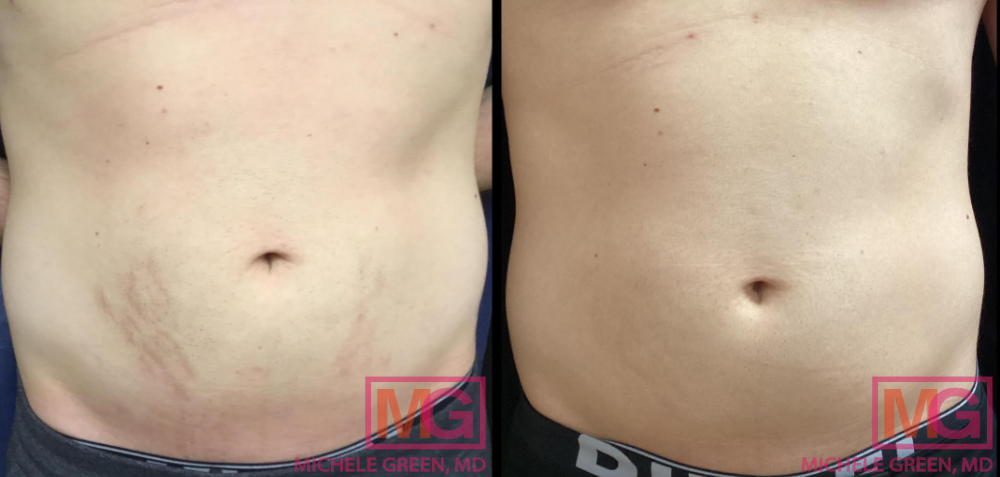
Frequently Asked Questions about Scar Treatment
When to start scar treatment
Scars can be an unsightly reminder of an injury, surgery, or acne breakout. Many patients want to reduce their appearance as soon as possible and often wonder, “When should scar treatment begin?” It is best to start treatments as soon as possible once the scar has fully healed to achieve the best results in regard to scar revision. If you are considering post-surgical scar treatment, you should prioritize the full healing process of the wound first before navigating through the various scar treatments available. To most effectively reduce acne scars’ appearance, whether atrophic, hypertrophic, or hyperpigmented, patients should no longer be experiencing active breakouts of acne lesions. Controlling acne breakouts is important in scar treatment since new acne lesions can create new scars. Before, during, and after your scar treatments, avoid sun exposure to the affected area by wearing protective clothing and SPF 50. The scarred skin area is highly susceptible to developing hyperpigmentation and skin cancer due to UV exposure.
When can I start scar treatment after surgery?
Generally, it is best to wait at least three months after a surgical procedure before considering scar reduction treatments. Ensuring the wound is completely closed and healed before undergoing scar treatments is essential. Post-surgical instructions must be followed carefully to prevent scar formation. After the wound is fully healed, the scar can be assessed by Dr. Green to discuss the best treatment options. Because there are so many options available for treating scars, it is best to consult an experienced, board-certified dermatologist like Dr. Green, who can determine what type of scar you have, when to start treatments, and which treatments would be safest and most effective.
How long does it take for a scar to go away?
The amount of time required to reduce the appearance of your scars will ultimately depend on your skin condition and type, as well as the severity, location, and types of scars present. Most scar treatments need to be spaced several weeks apart to allow the skin to heal between sessions. The majority of scar treatments also produce the best results when they are performed in a series. Thus, it can take six months or more to produce optimal results. When you consult with Dr. Green, she will establish a personalized treatment plan for your scar revision and work with you to develop a timeline that best suits your needs.
How to fade a scar quickly
Hyperpigmented scars can develop when the skin cells responsible for making melanin, melanocytes, produce too much pigment during the skin’s healing process. While no product or treatment can fade a scar quickly, procedures like chemical peels and microneedling can help to reduce discoloration and gradually create a more even skin tone. In addition, some targeted over-the-counter products can be paired with treatment to accelerate the healing process, fade discoloration associated with post-inflammatory hyperpigmentation, and brighten the skin. Serums containing active ingredients like vitamin C, azelaic acid, or alpha hydroxy acids, such as glycolic acid and lactic acid, are great topicals for reducing post-inflammatory hyperpigmentation. When you consult with board-certified dermatologist Dr. Michele Green at her private dermatology office in NYC, she will work with you to develop a customized skincare routine that includes the products best suited to your particular needs and goals.
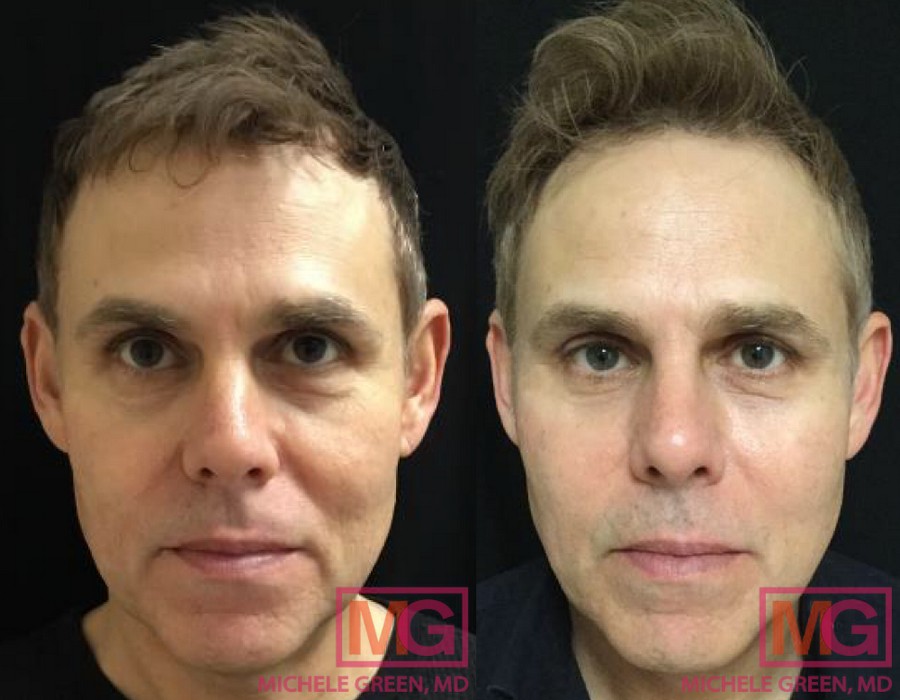
How much does laser scar treatment cost?
The cost of scar treatment depends upon various factors, including the size of the treatment area and the location, severity, type of scar present, and the experience level of your provider. Most patients require a unique combination of treatment options to achieve optimal results, which can also affect the overall cost of the scar treatment. Additionally, while it may be more cost-effective to treat scars at a MedSpa, consulting with a board-certified dermatology expert like Dr. Green is crucial to ensuring that treatment is safe, effective, and suited for your specific skin type, tone, and scarring. When you consult with Dr. Green regarding non-surgical scar revision, she will physically evaluate your skin condition, collect a thorough medical and family history, and review any previous scar treatments you may have had. She will then recommend the combination of treatments that are best suited to your particular needs and goals. At that time, the final cost of your scar treatment can be estimated.
Does insurance cover scar treatment?
Typically, scar treatment is considered cosmetic and is not covered by private insurance companies. However, you may be insured if there is documented evidence of functional impairment related to the scar, such as in a severe burn, and the treatment can be expected to improve function. The best way to determine your coverage is by contacting your insurance provider.
What types of oil should be used in a scar treatment?
Many oils have anti-inflammatory and healing properties that can benefit wound healing and scar treatment. Bio-oil is a highly studied topical treatment for scar and pigmentation treatment. Bio-Oil contains chamomile, calendula, and rosemary plant extracts, as well as retinol, to reduce the appearance of scars, stretch marks, and discoloration on the skin. Some patients look towards essential oils for scar treatment. Lavender oil carries anti-inflammatory, antioxidant, and antimicrobial properties that may help speed wound healing and cell growth to reduce the appearance of scars after an injury. Little research has been conducted on essential oil usage for scar treatment, and patients should be careful when using essential oils to ensure that no irritation occurs. Essential oils should be diluted with carrier oil, and a patch test should be performed on a small area of the skin to confirm that no allergic reaction occurs. If you are interested in using oils for scar treatment, it is best to consult with expert board-certified dermatologist Dr. Green to ensure that the oils are safe and effective.
Does vitamin E help with scars?
Vitamin E is best known for its ability to hydrate and protect the skin. Its antioxidant properties protect the skin from harmful free radical damage and environmental irritants. While vitamin E is excellent for preventing signs of aging and dehydrated skin, little research has been done on its efficacy for scar treatment.
Does massaging a scar help it go away?
Massaging a scar can help soften and improve its mobility. Regularly massaging the site can prevent scar tissue formation and flatten scars, reducing their appearance. Patients should wait to massage a scar until the wound has fully healed and any stitches are removed. Your plastic surgeon will advise you on the best massaging plan depending on the surgery you had and your skin condition. It is typically recommended to massage a scar for at least three months to achieve the best observable results.
Should you keep a scar covered?
During initial healing, it is essential to keep a scar covered to reduce the risk of infection, prevent sun damage, and promote faster healing. Silicone gel sheets are an excellent product to use when healing scars. By protecting the skin, these sheets can intensely hydrate the skin and regulate collagen production, allowing for flatter, smoother skin once the site is healed fully. Silicone gel sheets are especially effective for patients with a history of keloid scarring as they can prevent keloid formation.
Which scar removal cream is the best?
Patients in Dr. Green’s office often ask questions like “Which scar cream is best?” and “What is the best scar cream for old scars?” There are many types of creams over the counter that can be used to get rid of scars and reduce their appearance. The best topical creams for depressed or indented scars often contain retinol, a vitamin A derivative that gently exfoliates the skin, stimulates new collagen production and improves skin cell renewal. Silicone creams can be used to reduce the size and color of keloid scars. Silicone creams are available over the counter and do not require a prescription. Silicone products can be applied to old scars and those that are still healing, as long as the skin has healed over and the wound has closed. The exact scar removal cream that is best for you will depend on the type of scars you have, as well as your skin condition. If you are unsure what to use to get rid of scars, it is best to consult with board-certified dermatologist Dr. Green.
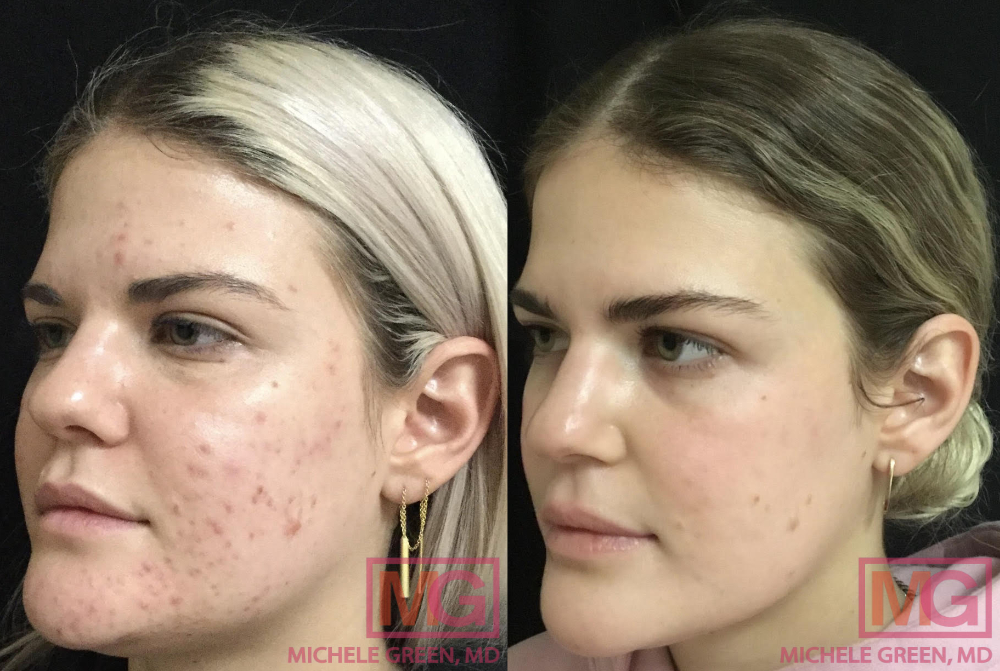
What’s the best treatment for scars?
Laser skin resurfacing treatments are highly effective in stimulating collagen production to reduce the appearance of various types of scars, including surgical scars, depressed acne scars, stretch marks, and burn scars, among others. Dermal fillers can restore lost volume to the skin caused by depressed and indented scars. Microneedling and chemical peels stimulate collagen production and reduce the appearance of depressed, flat, and pigmented scars. Utilizing the right combination of treatment options can make your scars completely unnoticeable. With so many treatment options available, it can be challenging to determine the best choice for your specific acne scars. When considering scar revision treatment, it’s advisable to consult with a board-certified dermatologist like Dr. Michele Green to understand which treatment is best for scar removal, depending on your specific scars, skin type, and skin condition tone.
Do scar treatments work?
Yes, scar treatments are incredibly effective in reducing the appearance of scars and helping restore self-esteem and self-confidence. While scars are permanent on the skin, non-invasive cosmetic procedures like laser resurfacing, VBeam laser, dermal fillers, microneedling, and chemical peels can all help stimulate collagen production and create a more even skin texture and tone. Patients experiencing hypertrophic or keloid scars can benefit from intralesional corticosteroid injections to flatten and shrink raised scars. Targeted skincare products like retinol and silicone can also aid and enhance results from treatment when used between sessions. When you consult with Dr. Green at her private dermatology office in NYC’s Upper East Side neighborhood, she will work with you to create a customized scar treatment plan that best suits your types of scars, skin type, and overall aesthetic goals.
How do I get started with scar treatments today?
Scars can develop as a result of an acne breakout, burn, injury, or wound. The appearance of scarring can negatively impact one‘s confidence, especially if they are located in visible areas like the face. Fortunately, non-invasive Scars can arise from an acne breakout, burn, injury, or wound. The visibility of scarring can adversely affect one‘s confidence, especially if located in prominent areas like the face. Fortunately, non-invasive treatment options such as resurfacing lasers, dermal fillers, microneedling, and chemical peels are offered at Dr. Green’s private dermatology office to diminish the visibility of scars and promote a more even skin texture. These procedures are preferred for scar treatment because of their safety, effectiveness, and consistently remarkable outcomes with minimal downtime. When considering scar treatment, it is wise to consult with a knowledgeable dermatologist like Dr. Green, who will leverage her expertise to identify the best treatment plan to help you achieve clear, smooth, and radiant skin.
Dr. Michele Green is an internationally renowned board-certified dermatologist with over two and a half decades of experience providing some of the world’s most discerning individuals with the finest non-invasive cosmetic procedures available, including lasers and fillers for scar treatment. She takes a holistic approach and embraces a less-is-more philosophy, consistently being recognized as a top dermatologist by Castle Connolly, New York Magazine, The New York Times, and Super Doctors for her dedication to her patients and her expertise. When you consult with Dr. Green at her private dermatology office in Manhattan’s Upper East Side neighborhood for scar revision, she will collaborate with you to develop a customized scar treatment plan that aligns with your needs and goals. To schedule a consultation with Dr. Green at her private dermatology office in Manhattan’s Upper East Side neighborhood, please contact us online today or call 212-535-3088.
 212-535-3088
212-535-3088